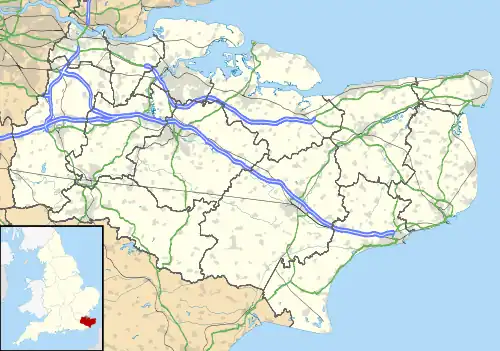| Church of St Mary, Chartham | |
|---|---|
 Church of St Mary, Chartham | |
 Church of St Mary, Chartham Location in Kent | |
| 51°15′21″N 1°01′05″E / 51.2559°N 1.0180°E | |
| Location | Chartham, Kent |
| Country | England |
| Denomination | Anglican |
| Website | |
| History | |
| Status | Parish church |
| Founded | c. 1285 |
| Architecture | |
| Functional status | Active |
| Heritage designation | Grade I |
| Designated | 30 January 1967 |
| Architectural type | Church |
| Completed | 1305 |
| Specifications | |
| Materials | knapped flint |
| Administration | |
| Province | Province of Canterbury |
| Diocese | Diocese of Canterbury |
| Archdeaconry | Canterbury |
| Deanery | West Bridge |
| Parish | Chartham |
| Clergy | |
| Vicar(s) | Revd Phil Brown |
St Mary's Church is in the village of Chartham, Kent, England. It is an active Anglican parish church in the Diocese of Canterbury. Constructed between 1285 and circa 1305, with a later tower of the fourteenth century. In 1875, the church was restored by George Edmund Street. St Marys is designated by English Heritage as a Grade I listed building.
History
An archaeological survey undertaken in 2010–11, found evidence of Romano-British and Anglo-Saxon habitation.[1] The present church dates from the late 13th century, with a traditional construction date of 1285.[2] A patent roll dating from the reign of Edward I records the partial remittance of a fine levied on the rector, "towards the works of his church begun by him".[3] The architectural historian John Newman notes that there is strong stylistic evidence to suggest the involvement of Michael of Canterbury, the master mason at Canterbury Cathedral.[3] The tower is later, of the fourteenth century.[2]
The church was restored between 1873 and 1875 by George Edmund Street.[2] It is designated by English Heritage as a Grade I listed building.[2]
In 2018, the Commissary General of the Diocese of Canterbury delivered a significant judgement on the installation of closed-circuit television at St Marys. Allowing the application, the Commissary sought to balance public-access requirements, for which CCTV was necessary on security grounds, and the privacy expectations of parishioners.[4] The church remains an active parish church with regular services.[5]
Architecture and description

The church is constructed of Kentish knapped flint with ragstone quoins. It is of cruciform design, with nave, transepts, chancel and tower.[3] The church has a number of features of particular note. The nave, transepts and crossing have "a magnificent series of c. 1300 timber roofs with large scissor-trussed rafters."[6] The windows in the chancel are considered amongst the very best examples of Kentish tracery.[3] The stained glass, although "much renewed in 1881 (has) enough glass of c.1294 to guarantee the authenticity of the whole".[3] The brass of the medieval knight, Sir Robert de Septvans, is one of the oldest in the country and "none are more memorable".[3] The church also contains monuments by Rysbrack and Thomas Scheemakers.[3]
References
- ↑ "Canterbury Archaeological Trust – St Mary's Church, Chartham". www.canterburytrust.co.uk.
- 1 2 3 4 Historic England. "Details from listed building database (1100352)". National Heritage List for England. Retrieved 26 January 2014.
- 1 2 3 4 5 6 7 Newman 2013, pp. 275–276.
- ↑ "Judgment St Mary Chartham [2018] PTSR 794; [2017] ECC Can 1; [2018] WLR(D) 101". Francis Taylor Building. 2 May 2018.
- ↑ "Services | St Marys Church, Chartham". stmaryschartham.
- ↑ "St Mary Church, Chartham - Architectural & Historical Information". Kentarchaeology.org.uk. 11 July 1991. Retrieved 26 January 2014.
Bibliography
- Newman, John (2013). Kent: North East and East. The Buildings of England. New Haven, US and London: Yale University Press. ISBN 9780300185065. OCLC 869127179.